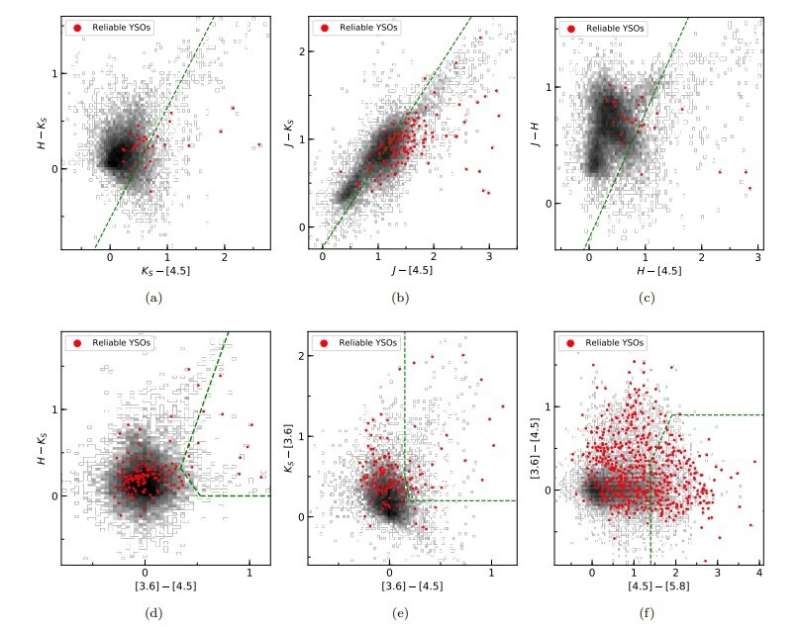September 16, 2019 report
Researchers study young stellar objects population in NGC 6822

Using NASA's Spitzer spacecraft, astronomers have conducted a comprehensive study of massive young stellar objects (YSOs) in the metal-poor galaxy NGC 6822. The research, detailed in a paper published September 9 on the arXiv pre-print repository, resulted in identifying hundreds of new YSOs in this galaxy.
YSOs are stars in early stage of evolution, in particular, protostars and pre-main sequence stars. They are usually observed embedded in dense molecular clumps, environments containing plenty of molecular gas and interstellar dust.
Located some 1,600 light years away from the Earth, NGC 6822 is an isolated, gas-rich and metal-poor barred irregular galaxy. Taking into account the galaxy's proximity, its isolation and low metallicity, it seems to be an ideal target for studying resolved stellar populations.
However, although many studies of star-forming regions in NGC 6822 have been conducted, its massive young stellar population has been more difficult to characterize on a global scale. Hence, NGC 6822 lacks global surveys of its YSOs and studies of how these objects relate to the galaxy's gas and dust distributions.
A team of astronomers led by Olivia Jones of the Royal Observatory in Edinburgh, U.K., has now investigated massive YSOs in NGC 6822. Their research is based on data collected by Spitzer's two instruments: the Infrared Array Camera (IRAC) and the Multiband Imaging Photometer for Spitzer (MIPS).
"We present a comprehensive study of massive young stellar objects (YSOs) in the metal-poor galaxy NGC 6822 using IRAC and MIPS data obtained from the Spitzer Space Telescope," the researchers wrote in the paper.
The study found over 500 new YSO candidates in seven massive star-formation regions of NGC 6822. 90 YSO candidates, which comprise the highest number in this galaxy, were detected in the newly discovered Spitzer I region of active star formation.
According to the paper, most of the newfound candidates are massive protostars with an accreting envelope in the initial stages of formation. About 25 percent of YSOs from the sample have an average mass greater than 15 solar masses. However, the researchers noted that the mass estimates still have large uncertainties, and further studies are required to gather more detailed information.
The study also calculated the global star-formation rate for NGC 6822. This value turns to be about 0.04 solar masses per year, which is consistent with previous observations of this galaxy, however, it is higher than star-formation rate estimates based on integrated ultraviolet fluxes.
In concluding remarks, the astronomers emphasized the importance of their research into NGC 6822 and the YSO population within it. "This is the first catalogue of young embedded stars in the process of formation identified in the galaxy," the scientists wrote in the paper.
They added that future observations of NGC 6822 using NASA's James Webb Space Telescope (JWST) could reveal the presence of more YSO candidates at all stages of evolution.
More information: Olivia C. Jones, et al. The Young Stellar Population of the metal-poor galaxy NGC 6822, arXiv:1909.03884v1 [astro-ph.GA]: arxiv.org/abs/1909.03884
© 2019 Science X Network




















